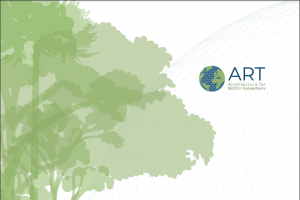Mobilizing Large-scale Climate Solutions from the Forest Sector, Introducing TREES 2.0EM Strategic Supporter Insights
Accelerating progress toward national scale accounting and implementation to achieve emissions reductions and removals at scale and to achieve Paris Agreement goals.

24 August 2021 | The Architecture for REDD+ Transactions (ART) has released an expanded and enhanced version of The REDD+ Environmental Excellence Standard (TREES) for measuring, monitoring, verifying and crediting climate progress in the forest sector. The updated version – TREES 2.0 – broadens opportunities to unlock large-scale solutions from forests in support of efforts by the international community to achieve the ambitious goals in the Paris Agreement.
In the fight against climate change, the urgency of reducing deforestation, restoring and regrowing forests and protecting intact ecosystems in areas with low historic rates of deforestation is well understood. Scientists estimate that these natural climate solutions can provide one-third of needed climate action this decade.
The Paris Agreement paved the way for large-scale climate solutions from forests by endorsing international cooperation to protect and enhance forest carbon stocks and reduce emissions from deforestation and forest degradation, collectively known as REDD+. However, a major barrier to mobilizing large-scale finance has been the lack of a high-integrity, standardized approach for the measurement, monitoring, reporting, verification and crediting of emission reductions and carbon removals from forests at a jurisdictional scale, including the assurance of environmental and social safeguards.
ART was created to meet this challenge with the objective of attracting finance at scale to support ambitious climate action in the forest sector by countries and large sub-national jurisdictions (such as provinces or states) by ensuring that TREES emission reduction and removals credits are comparable across jurisdictions and fungible in carbon markets with credits from other sectors. The first version of TREES, released in 2020, focused on ensuring the integrity of credits for emission reductions from reduced deforestation and forest degradation – the most urgent priority for the forest sector.
TREES 2.0 includes innovations to broaden access to and activities covered by forest carbon crediting, while maintaining rigorous safeguards. TREES 2.0 expands options for participating jurisdictions to access carbon market financing by including crediting for additional mitigation actions from the forest sector notably (i) protecting forests in jurisdictions with high forest cover and low rates of deforestation and (ii) enhancing carbon ‘removals’ due to reforestation and forest restoration efforts. It also creates a pathway to recognize the contributions of Indigenous Peoples to protecting forests and reducing associated emissions.
Specifically:
- TREES 2.0 expands jurisdictional-scale crediting for forest restoration and the establishment of new forests – which remove carbon from the atmosphere – adding another critical solution to help drive transformational change in the forest sector and achieve the goals of the Paris Agreement.
- TREES 2.0 adds an innovative crediting approach for jurisdictions that have historically protected their forests. These are areas that have high forest cover and low levels of deforestation (also known as High- Forest, Low Deforestation (HFLD) jurisdictions). Incentivizing jurisdictions to keep their forests standing creates a more effective and equitable global system for forest protection and restoration.
- TREES 2.0 creates a new opportunity for Indigenous Peoples – who provide a critical global service as effective forest protectors – to contribute and benefit. Indigenous Peoples territories are eligible to aggregate as subnational accounting areas as part of a national submission to ART to meet the required scale threshold. In addition, these subnational Indigenous Peoples territories are eligible to qualify as HFLD and therefore elect to use the TREES 2.0’s HFLD crediting approach to better reflect their historical performance in protecting their forests.
ART has also clarified requirements to avoid double counting and improved requirements around uncertainty, while also enhancing clarity for how project-level activities can fit within a jurisdictional approach, as well as how TREES operationalizes the social and environmental safeguards defined by the United Nations Framework Convention for Climate Change (UNFCCC) for the implementation of REDD+ activities – known commonly as the Cancun Safeguards.
Specifically:
- TREES 2.0 clarifies provisions to avoid double counting under the Carbon Offsetting and Reduction Scheme for International Aviation (CORSIA) and the Paris Agreement’s Article 6.2 (which provides an accounting framework for international cooperation to achieve national climate goals). It also clarifies situations in which credits issued for use in domestic compliance markets may not be considered double issued with TREES credits.
- ART has also clarified that while ART does not directly credit projects or similar smaller-scale activities, ART recognizes that Participants will work with the private sector, Indigenous Peoples and local communities (IPLCs) and other stakeholders to design and implement successful REDD+ programs. To complement TREES 2.0, ART recently published a paper detailing Options for Nesting Under ART.
Despite universal agreement on the essential role of forests in achieving the goals of the Paris Agreement and reversing the worst effects of global warming, they are being lost at alarming rates. We urgently need to mobilize capital at scale for protecting and restoring tropical forests. By expanding access to carbon market finance, our goal with TREES 2.0 is to unlock such large-scale action from the forest sector.
Please see our Reprint Guidelines for details on republishing our articles.

